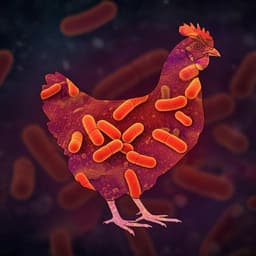
Food Science and Technology
Centralized industrialization of pork in Europe and America contributes to the global spread of *Salmonella enterica*
H. Li, Y. Wu, et al.
This captivating study explores the effects of intensive farming and global transportation on the evolution of *Salmonella enterica*, a significant zoonotic pathogen. By examining over 9,000 genomes from pig-associated populations, the authors unveil the strong links between the global pork trade and these pathogens’ emergence. Discover how modern pig agriculture plays a pivotal role in antimicrobial resistance and the worldwide spread of salmonella.
~3 min • Beginner • English
Introduction
Salmonella enterica infiltrates food supply chains via contamination of food, water, or processing facilities, causing an estimated 108.1 million illnesses and 291,000 deaths annually. Pigs and pork are prominent reservoirs and sources, responsible for approximately 31.1% of salmonellosis and 9.3% of outbreaks in the EU. Despite pigs’ recognized role in viral disease spread, their contribution to the global dissemination of bacterial pathogens, including S. enterica, is less understood within a One Health framework. Over the past century, intensive farming and global trade have transformed pig agriculture, with Europe and the United States becoming major industrial hubs representing over 32% of pork and breed trades. Although many of the >2,000 S. enterica populations (serovars/eBGs/ceBGs) are ubiquitous, a subset is pig-enriched, yet how these populations disseminated globally and how modern agriculture reshaped their dynamics remained unclear. This study addresses these gaps by analyzing global genomic data to reconstruct population dynamics, host transfers, resistance acquisition, and international transmission patterns of pig-enriched S. enterica.
Literature Review
The paper references prior work on food safety and disease burden, pig-associated salmonellosis in the EU, globalization of agricultural trade, and previous phylogenomic studies of Salmonella and related host-adapted lineages (e.g., Typhimurium and Para C lineages). It notes earlier regional studies on Choleraesuis and pig-associated clades, the emergence of quinolone resistance in Salmonella, and examples of pathogen spread through global trade (e.g., poultry breeding stocks). However, a comprehensive, dedicated literature review section is not presented; instead, relevant literature is integrated throughout the introduction and discussion to contextualize findings.
Methodology
- Data sources: Downloaded metadata for 362,931 S. enterica strains from EnteroBase (July 2022), classified into seven source categories (pig, bovine, poultry, human, other animals, food and environment). Identified 61 ceBGs with ≥20 pig strains (277,588 strains total). Selected 9 pig-enriched ceBGs (>40% pig-associated strains; 9,259 genomes) for detailed analyses, and 8 pig-containing ceBGs (2–40% pig-associated; 16,829 genomes) for comparison.
- Additional sequencing: Generated 78 new Choleraesuis genomes (63 from Germany/Austria via UoWUCC 10K project, 15 from China CDC), integrated with 679 public genomes and one ~1,600-year-old reconstructed genotype to form a global set of 757 Choleraesuis genomes from 41 countries.
- Genome processing: Reads trimmed with EtoKi prepare; assemblies via SPAdes v3.13 (EtoKi assemble); annotation with PROKKA 1.14.6 and functional prediction by eggNOG-mapper v2. AMR genes predicted using AMRfinder v3.11.14; disrupted genes predicted with PEPPAN.
- Phylogenomics: Core-genome SNP alignments per ceBG via EtoKi align; recombinant regions removed with RecHMM; maximum-likelihood trees built using IQ-TREE v1.6.12.
- Temporal signal: Evaluated using TempEst (root-to-tip regression), date randomization (10 permutations), and BactDating substitution rate comparisons; performed across Choleraesuis and eight other pig-enriched ceBGs.
- Dating and phylodynamics: For Choleraesuis, tip-dated BEAST 2 analyses (tested clock and population models; best model: optimized relaxed clock + Bayesian skyline) to obtain an MCC tree. BactDating used for all pig-enriched ceBGs; convergence ensured (ESS>100) and best models selected via Bayes factors. Effective population sizes estimated (e.g., ‘skygrowth’ in R for Choleraesuis).
- Ancestral state reconstruction: TreeTime used to infer ancestral hosts and geographic origins; host transfers and international transmissions identified when ancestor and descendant nodes differed in state.
- Downsampling to mitigate sampling bias: Reconstructed phylogeography with at most 10 or 5 genomes per country (100 replicates each), summarizing origins of major clades.
- Trade-transmission correlation: Compiled intercontinental trade flows for 5,014 product categories from Harvard Dataverse (inflation-adjusted constant USD). Calculated normalized cross-continental trade fluxes and pathogen transmission frequencies among five continents. Computed Pearson correlations and projected goods and pathogen transmission patterns via UMAP based on 1−R distances. Examined correlations for specific pig-related product subclasses (e.g., frozen/processed pork, live pigs).
- Definitions and normalization: Quantified transfer frequencies Tij normalized by total influx into target state; aggregated to continent-level Tmn values.
Key Findings
- Scope of pig association: Among 362,931 EnteroBase Salmonella strains, pigs/pork accounted for 17,623 (4.9%) across 252 ceBGs and were the second most frequent livestock source after poultry. Identified 61 ceBGs with ≥20 pig-related strains; 9 ceBGs were pig-enriched (>40% pig-associated), including Choleraesuis (ceBG1272) and Derby (ceBG3).
- Recent international spread: Within pig-enriched ceBGs, 35 HC5 clusters spanned ≥2 countries (15 across continents), and all international HC5s contained at least one pig strain, indicating recent long-range transmission linked to pigs/pork.
- Choleraesuis phylogeography and diversity: Three lineages (CS1–CS3) defined by ~22k core SNPs and separated by 2,932–12,435 SNPs. Regional clustering observed (e.g., China/Vietnam in clade 1.2; UK in 1.1; US strains largely with Taiwan in 2.2; >60% European wild boar in 2.3). Simpson’s diversity indices indicated highest clade diversity in Western/Northern Europe (0.66–0.70), moderate in South America/East Asia (0.63), and lowest in Africa/North America (0.14–0.17), suggesting Europe as the main genetic repository and probable origin.
- ARG accumulation and host associations: Choleraesuis carried substantially more ARGs than Paratyphi C (diverged ~4,000 years ago). Human and livestock strains carried ~9× more ARGs than wild boar strains. High resistance in pigs to aminoglycosides, sulfonamides, tetracyclines, and beta-lactams (common in feed). Clinical resistances (quinolones, trimethoprim, cephalosporins) were fewer and mainly in human strains. Colistin resistance genes mcr-1 and mcr-3 detected in 8 human/pig strains spanning the UK, China, Brazil, and Germany. ARG carriage rose post-1970s (CS1 and CS2) with a drop in CS2 after 2010s due to increased wild boar sampling.
- Temporal dynamics and origins: Bayesian dating placed the Choleraesuis MRCA in Europe before 2394 BP (95% CI 2276–2521 BP), with divergence into CS1 (~1785) and CS2 (~1870). First transmission out of Europe to the US predicted before 1893 (95% CI 1891–1896). Effective population size expanded in the early 20th century, peaking in the 1930s, then a second expansion occurred in the 1950s–1980s, aligning with livestock revolution and trade globalization; peak around 1985 followed by declines and reduced long-range transmissions.
- Downsampling robustness: Even with stringent per-country downsampling (≤10 or ≤5 genomes), North Europe remained the most probable origin of Choleraesuis overall; minor differences at sub-lineage levels arose from sparse basal clusters in some countries.
- Host jumps and establishment: Of the nine pig-enriched ceBGs, all but Choleraesuis and Derby were inferred to have originated in non-pig hosts and jumped into pigs mainly after 1930, coinciding with intensive farming. In Derby (ceBG3), at least eight human-to-pig transfers occurred between 1906–1942, establishing contemporary pig-enriched lineages. No broad pseudogene accumulation was detected in pig-enriched populations (except Choleraesuis with >17.3% disrupted genes).
- Recent host transfer patterns: In the past 50 years, pigs contributed the majority (30–60%) of recent host transfers (including into humans) for pig-enriched ceBGs; in contrast, pigs contributed much less to transfers in ceBGs with only 5–35% pig strains.
- Intercontinental transmission sources: Across all nine pig-enriched ceBGs, 68–96% of transmissions into each continent originated from Europe or the Americas, paralleling patterns of pork-related trade flows.
- Trade-pathogen correlations: UMAP of Pearson correlations placed pig-enriched Salmonella transmission with a cluster of pig-related products (frozen/processed pork, offal, fat). Very high correlations with frozen/processed/offal categories (R≈0.87–0.96; P<0.0001); moderate but significant correlations with fresh pork and live pigs (R≈0.46–0.72). Product-level subclass analyses showed R up to 0.96 for frozen pork and 0.94 for frozen offal.
- Antimicrobial resistance threats: 38% of human and 10.8% of pig Choleraesuis strains exhibited quinolone resistance (via QRDR mutations or ARGs), often alongside multi-resistance to agents used in animal and clinical settings (notably in clusters 1.1.1, 1.2.1, 2.2.4).
Discussion
The study demonstrates that modern pig agriculture—characterized by intensive farming, widespread antibiotic use, and globalized trade—has profoundly shaped the evolution and dissemination of pig-enriched S. enterica. Phylogeographic analyses indicate Europe as the primary genetic reservoir and probable origin of Choleraesuis, with historical and mid-20th-century expansions corresponding to agricultural intensification and globalization. Host-jump timing and transfer patterns implicate pig populations as hubs driving onward transmissions, including into humans, over the last half-century. The strong alignment between intercontinental transmissions of pig-enriched Salmonella and trade in frozen/processed pork and offal suggests that centralized industrial pork production and commodity flows are key drivers of global spread. The elevated AMR burden in human and livestock strains relative to wild boar underscores the impact of antimicrobial use in agriculture on resistance emergence, reinforcing One Health strategies to curb overuse and mitigate public health risk. Region-specific trade relationships (e.g., Europe–mainland China vs. US–Taiwan) explain distinct local Choleraesuis clade compositions, illustrating how trade routes shape pathogen phylogeography.
Conclusion
This work provides a comprehensive genomic and phylodynamic assessment linking modernization and globalization of pig agriculture to the emergence, expansion, AMR acquisition, and intercontinental dissemination of pig-enriched S. enterica. Key contributions include: (1) identification of nine pig-enriched ceBGs and evidence of widespread recent international transmission; (2) reconstruction of Choleraesuis global phylogeography with Europe as a main genetic repository and origin, and temporal expansions aligned with agricultural intensification; (3) demonstration that pigs and pork are primary conduits for recent host transfers; and (4) quantitative alignment of intercontinental pathogen transmissions with pork-related trade, especially frozen/processed products and offal. Future research should expand genomic surveillance in under-sampled regions (Africa, South America), integrate supply-chain and feed route data to resolve local transmission dynamics, evaluate interventions in trade and feeding practices (e.g., restrictions on swill feeding, enhanced processing hygiene), and implement One Health frameworks to reduce antimicrobial use and slow AMR emergence.
Limitations
- Sampling bias: Public genomic datasets are skewed toward developed countries, underrepresenting diversity in many developing regions, especially in South America and Africa.
- Downsampling trade-offs: While downsampling reduces bias, it can over-emphasize countries with low genetic diversity when basal lineages are sparsely sampled.
- Limited resolution of local transmission: Insufficient data to assess within-country transmissions tied to national transportation networks or wild boar movements.
- Potential ascertainment effects: Historical changes in sampling intensity and source attribution may influence inferred temporal dynamics and host-transfer frequencies.
Related Publications
Explore these studies to deepen your understanding of the subject.







